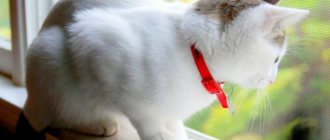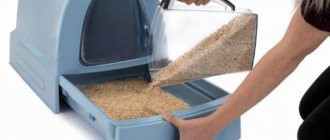Even domestic cats can become victims of blood-sucking parasites, not to mention pets that are regularly outdoors. A flea and tick collar is a convenient and effective accessory that can be used to protect cats from annoying insects.
There is a fairly wide range on the market, allowing you to choose the most suitable option, taking into account the gender, age and individual characteristics of your pet.
Operating principle
An anti-flea collar is a flexible strip made of polyvinyl chloride, textile or silicone. The material is impregnated with special substances to repel (repellents) or destroy (insecticides) parasitic insects.
Flea collars for cats begin to work as soon as they are placed on the animal's neck. During wearing, the product bends, stretches, and heats up, which promotes the release of the active substance, some of which gets onto the pet’s skin and fur. As a result, the parasites either die or leave the animal.
In a collar
When choosing which product is best to use - a collar or flea drops, cat owners are guided by their own preferences, since both products have both advantages and disadvantages. It is believed that a collar is more suitable for prevention, while drops are effective in case of an existing flea infestation.
How to make a collar with your own hands
There is an opinion that a flea collar is quite easy to make with your own hands. As for the independent use of insecticides, this is strictly not recommended, as it is fraught with toxic poisoning and allergies of the pet. The fact is that it is impossible to achieve a gradual release of such a remedy at home.
But you can make your own bio-collar by soaking a strip of fabric or paper with plant extracts that repel insects. These are oils of geranium, citronella, margosa, lavender, rosemary, eucalyptus and their combinations. The advantage of this method is the ability to try different scents and choose the ones that are least irritating to the cat, as well as the ones that are most effective against parasites. However, it must be remembered that allergic reactions are possible to natural products, as well as synthetic ones.
Citronella oil is considered one of the most effective insect repellents
A handmade collar will work until the active ingredients disappear, so it will need to be regularly updated or a new one made.
Advantages and disadvantages
When choosing a flea collar, you need to consider all the pros and cons of the accessory. Benefits include:
- versatility (used both for prevention and for getting rid of insects, you can choose the best option for an animal of any age);
- simplicity and ease of use (the collar is easy to put on and can be removed at any time);
- availability (available in all pet stores, very loyal pricing policy);
- safety (the active drug does not penetrate the cat’s blood);
- long lasting effect;
- the accessory looks attractive , and in addition it can be used as a sign by writing the owner’s phone number or address.
The main disadvantages include the following:
- insufficient effectiveness (the collar is good for prevention, but for getting rid of ticks the concentration of the active substance is not high enough);
- unpleasant odor (at first it causes anxiety for the animal, but after 7-10 days it practically disappears);
- the risk of an allergic reaction (substances with which the collar is impregnated can cause contact dermatitis in some animals);
- skin damage (the accessory can rub the delicate skin on the neck, this situation is especially common in representatives of hairless breeds, for example, Sphynxes).
If your cat is outdoors, wearing a collar can be a source of increased danger. For example, an animal may get caught on a branch or nail in a fence.
Types and features
All collars according to the principle of operation are divided into two types:
- bio collars that repel fleas;
- accessories impregnated with insecticides that cause the death of insects.
The operating principle of the product and the rules for its use are indicated in the instructions.
Biocollars for cats
Biocollars do not contain chemicals, and their action is based on the use of natural ingredients. Most often, the accessory is impregnated with a composition containing essential oils.
Biocollar
The most common plants for controlling parasites are:
- rosemary;
- sagebrush;
- eucalyptus;
- geranium;
- cedar.
This type of collar mainly works only to protect the animal from fleas. If there are already insects, then you first need to get rid of them, and only after that put on the accessory.
Insecticidal flea collars
More effective flea collars for cats are impregnated with a chemical that may contain the following compounds:
- imidacloprid;
- amitraz;
- cyphenothrin;
- permethrin;
- fipronil.
The active substances affect insects by blocking nerve impulses, as a result of which the parasites stop feeding and reproducing and die. Such collars are low toxic and not dangerous for cats, but they get rid of fleas quickly and reliably.
Important! You cannot wash your animal with anti-flea shampoo or treat it with special drops less than 10 days before using the collar. Otherwise, the accumulation of toxic substances in the pet’s body can cause intoxication.
Service life and efficiency
A flea collar for cats is effective as long as a sufficient amount of active substance particles remains in it. The effectiveness of the product decreases gradually. The validity period largely depends on the type of collar. A product impregnated with a repellent will last 2-3 months, and a product treated with an insecticide will last from 6 to 8 months. After this period, the collar remains just a cute accessory that hardly helps protect cats from fleas.
More detailed information about how long to wear a particular flea collar for cats is indicated in the instructions for the product.
Wearing rules
When purchasing an anti-flea collar for cats, you need to know the basic rules for its use in order to save the animal from inconvenience and yourself from eliminating unwanted consequences. Basic recommendations:
- the accessory should be printed immediately before use;
- first, the collar must be stretched and kneaded a little;
- in cases where treatment with flea drops was carried out, you can put a collar on the cat no earlier than 10 days after the procedure;
- the accessory should fit snugly enough to the fur, but not squeeze the animal’s neck (a gap of about 1 cm should be left between the collar and neck);
- The collar must be properly secured with a clasp, and the dangling end must be cut off so that the cat cannot lick or chew it.
Wearing rules
You should not put collars on your cat that are intended for other animals, such as dogs. Exceeding the dosage of the active substance may cause illness or poisoning of the pet.
How to use a flea collar correctly
Before using the product, be sure to read the instructions and the rules contained therein.
Using the collar is extremely simple. Open the package, take out the medical accessory and carefully put it on your pet. At the same time, the tape should be attached to the cat’s neck in such a way that it fits tightly enough, but at the same time does not cause discomfort to the animal. If it becomes necessary to temporarily remove the collar (for example, when washing a cat), you should place it in a sealed bag so that the product does not dry out.
The validity period for collars of different brands may vary and ranges from 2 to 7 months , after which the item is replaced with a new one.
When using a collar, it is highly undesirable to simultaneously use other antiparasitic agents. Excess toxic substances will negatively affect your pet's health.
And you should know that the collar is ineffective against a serious flea infestation, because first of all it is a protective device. In advanced cases, you must first treat the cat with other means (for example, flea shampoo for cats) and only then, after 8-10 days, use a collar so that the pet is protected from repeated invasion by uninvited guests.
How to choose the right collar for your pet?
The effectiveness of a flea and tick collar largely depends on its quality. Therefore, you need to choose an accessory carefully, taking into account some nuances:
- You need to purchase a collar only in a specialized store;
- It is advisable to choose a product from a well-known brand;
- the collar must be packed in a hermetically sealed bag;
- Instructions must be included with the product;
- you need to check the expiration date and availability of a valid certificate for the collar;
- The product must be appropriate for the age and weight of the pet.
For kittens, pregnant and lactating cats, and older animals, you need to purchase an anti-flea collar designed specifically for this category.
Precautionary measures
The substances included in the impregnation of a cat flea collar do not pose a danger to humans, but if they get on the skin, they can cause an allergic reaction. The products can also pose a threat to small children who like to taste everything.
Follow safety precautions
Following simple safety rules will help you avoid health problems:
- While putting a flea and tick collar on cats and kittens, you should not eat or smoke;
- After putting the accessory on an animal, you must wash your hands thoroughly;
- be sure to ensure that the accessory does not fall into the hands of children or into the mouth of a pet;
- The collar should be stored in a place protected from light, away from food.
At the first signs of poisoning, you should immediately consult a doctor.
Reviews from veterinarians and buyers
Svetlana, Voronezh . In the summer, while at the dacha, our pet interacted with street cats and picked up fleas. No matter how much we tried, we could not cope with the problem. The imported version of Bolfo came to the rescue. Although the price is high, the effect is 100%. They put it on once and forgot about it, although the cat still had the same lifestyle. I recommend.
Valentina, Saratov . We live in a private house. We got a cat. Naturally, he constantly walks outside and communicates with other animals. The problem of fleas is urgent. We purchased a Hartz collar. Forgot about the problem forever. Now we just change the collar every 4 months.
Ekaterina, Ekaterinburg . We bought a Bars collar. An allergy appeared, the area on the neck turned red and hair began to fall out. They urgently changed the manufacturer. We bought Bolfo. The allergy problem quickly disappeared. Everything is fine now. Thanks to the manufacturer.
A flea and tick collar for cats is an effective means of combating parasites, as the animal is provided with protection from several weeks to several months. You must always ensure that it is flexible. Otherwise, it may pose a threat to the cat, which, for example, clings to branches. For domestic cats, it is advisable to use a collar containing essential oils.
Contraindications
Before choosing a flea collar and putting it on your cat, you need to make sure that your pet has no contraindications, which include:
- age (collars are not recommended for kittens under 1.5 months of age and older animals);
- health status (cats with weakened immune systems or existing diseases should not be protected from fleas with a collar);
- tendency to allergies (the active substance can cause lacrimation, vomiting, and skin irritation).
You should also refrain from using a collar if the cat has abrasions, scratches or other damage to the skin on its neck.
Collars for kittens and pregnant cats
There are special collar models for kittens that are safe and small in size. Some products are suitable for both adult cats and kittens. The packaging or instructions should indicate at what age the collar can be used. The best option for kittens and pregnant cats are biological collars. But they are also recommended for use no earlier than 2 months of age.
For kittens, it is better to purchase special models with a small diameter and a safe composition of active ingredients.











